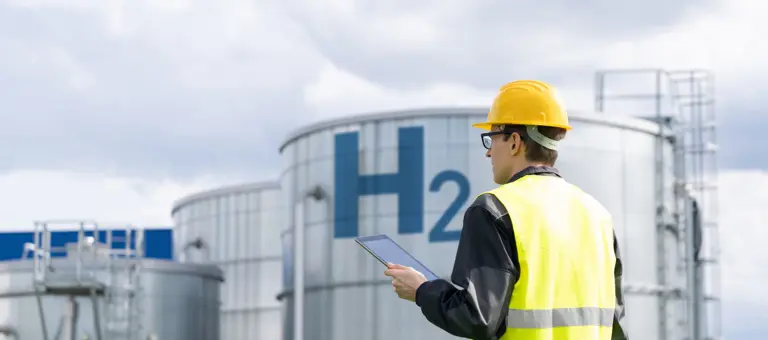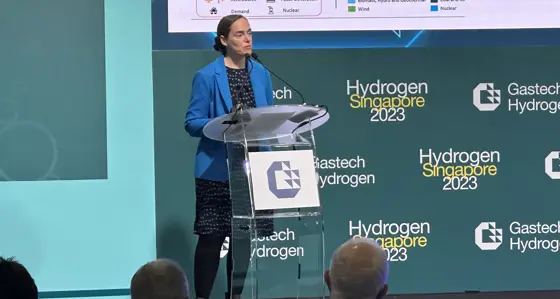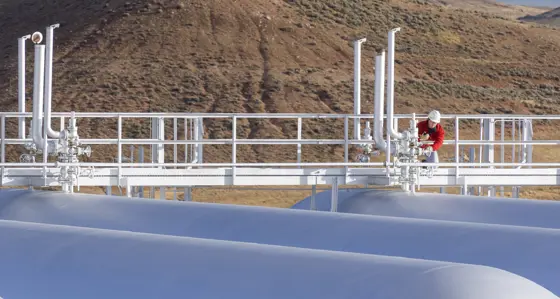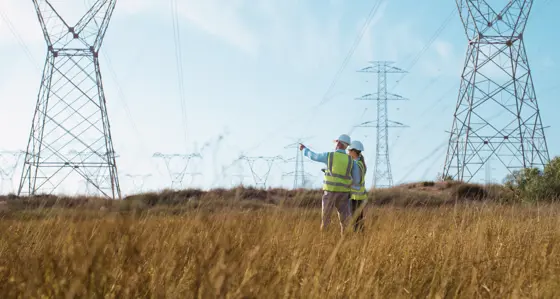
The hydrogen investment challenge: Incorporating learnings and overcoming barriers
6 min read 8 May 2024
In April, Baringa brought together developers and financial institutions for a Hydrogen Roundtable.

The Baringa host Molly Iliffe, global head of hydrogen, opened the roundtable by commenting that it’s been four months since the Department for Energy Security and Net Zero (DESNZ) announced the results of the UK's first hydrogen allocation round (HAR1), making it a good time to reflect on lessons learned and ongoing barriers to investment in this critical area for UK net-zero targets.
The vibrant debate had a range of perspectives on:
- Positive developments in this nascent industry
- Ongoing challenges to reaching a final investment decision (FID) and delivering commercially viable projects – including those related to offtakers, grid connections, electricity sourcing and risk evaluation
First, the UK is in a strong position when it comes to hydrogen
There was general agreement that the UK environment is broadly favourable to hydrogen.
Our roundtable participants recognised DESNZ’s expertise, its work developing the Low Carbon Hydrogen Agreement (LCHA) and the first contracts awarded under HAR1. One investor called the hydrogen production business model “the best business model globally for hydrogen.”
In addition, the UK’s industrial base, geology, and wind assets create solid fundamentals, as does its experience moving gas cost-effectively. The most economical way to distribute hydrogen is through a repurposed natural gas pipeline network, and the UK is in a strong position to develop this.
Government is also enabling investment through the UK Infrastructure Bank. Rajesh Kedia, its director of banking and investments, affirmed that hydrogen is a key focus sector. “We are open to exploring opportunities across the hydrogen value chain in the UK. Although there are challenges, there are green shoots,” he explained. “We have done two investments in the UK Hydrogen sector. We’re also seeing projects that aren’t totally dependent on UK Government subsidy and have credible sponsors, and counterparties. There may also be opportunities in the supply chain.”
Catherine Wainwright, commercial lead of EETH’s hydrogen production projects HPP1 & 2, director of Vertex Hydrogen, and head of commercial at Progressive Energy, also emphasised the progress: “Three years ago, we didn’t have a business model and didn’t know how Government was going to subsidise hydrogen. Now, we have a fully termed contract (LCHA). Then, we didn’t know what low-carbon hydrogen meant; now, we have the UK Low Carbon Hydrogen Standard on version 3 which clearly deals with refinery offgases and different feedstocks."
But how can we overcome challenges to accelerate the hydrogen economy?
Despite the positive fundamentals, attendees faced similar barriers to enabling projects to reach FID.
These primarily related to:
- Offtaker commitments
- Grid connections
- Electricity sourcing
- Risk evaluation
Let’s look at each of these, along with the potential solutions we discussed.
Offtakers
The challenge: Difficulty securing commitments
Dharmesh Jadavji recently joined Baringa and is focussing on hydrogen advisory in GB and Ireland after leading DESNZ’s hydrogen business model allocation teams. He explained that “there’s no viable project without committed offtakers that really need hydrogen to decarbonise. In HAR1, I saw developers with good offtaker engagement still see their offtakers fall away or reduce demand late into the process, because their international leadership hadn't yet committed to hydrogen as the decaronisation pathway. If anchor offtakers can’t commit, and sign long-term agreements, the project isn’t viable.”
Hannah Bronwin, director of business development for SSE Thermal, noted that “most users are switching from natural gas which they may only hedge out 12 to 18 months, maximum. Moving to long-term take-or-pay commitments for fuel would be a big change for them.”
Potential solutions
- Progressed transport and storage – As infrastructure is built and scaled, and if it can be strategically aligned with key demand centres, it will make it easier for producers to meet viable demand and mitigate against offtakers supply concerns.
- Perception change on costs – There’s no getting around the fact that decarbonisation comes at a price. As one attendee noted: “When you buy natural gas or grey hydrogen, you get one utility – energy. When you buy green hydrogen, you get two utilities – energy and decarbonisation. It’s more expensive because you’re buying two utilities, and people need to be realistic costs won’t hit rock-bottom prices (even though they will come down).”
- Cost of abatement - Hydrogen will be appropriate for some offtakers, such as fertiliser, steel production and non-road mobile machinery, but less appropriate for others which could electrify or deploy carbon capture and storage. To future proof projects, producers should focus on building around anchor offtakers who have few alternatives, and where hydrogen offers the lowers cost pathway to decarbonise.
- Incentives to switch – Offtakers need to invest capex to be hydrogen-ready, and they have other priorities in the current climate. Without ways to recover those capex costs, and appropriate carbon pricing (and carbon border adjustments) to incentivise fuel switching, it will be hard to galvanise early adopters.
Grid connections
The challenge: They’re too uncertain and take too long
It’s a constrained environment from a grid connection perspective. Hannah Bronwin cited grid connection difficulties as a major obstacle for many projects. “The process is opaque and slow,” she said. “Will the connection be available and scalable? Will DNO/ESO transmission impact assessments push back connection dates? Will locational pricing be introduced and apply to hydrogen?”.
Another attendee emphasised that this is a particular problem for green hydrogen because it’s hard to guarantee grid connections within HAR delivery windows.
Potential solutions
- Process reforms – In terms of Ofgem operations, bill protection systems, and how network connections are affirmed, to account for the nuances of hydrogen.
- More flexible HAR delivery windows – This was controversial in our discussion. It was recognised that the Treasury constraints when it comes to budget or approved levy cover necessitate fixed delivery windows; however, there could be scope for more flexibility in subsequent years to deal with uncertain grid connectivity timescales.
Electricity sourcing
The challenge: Procuring enough power at viable prices
Electricity is 60 to 70% of the cost of green hydrogen production, but it’s hard to source it at a price that makes project finances stack up. As one attendee noted: “You have to find base load power from somewhere, but no one is offering block power in the UK.”
Even developers with renewables portfolios found this difficult.
Potential solutions
- Make minimising electricity costs a 'red line' – Initial project planning must consider reducing the use of expensive grid connections, the ability to supply offtakers as flexibly as possible, options for connecting to multiple renewables assets, and power purchase agreements (PPAs) that give optionality - and shape project design around this.
- Focus on key early decisions – Certain early decisions constrain future cost reduction opportunities. These include plant location, grid connection size, renewables assets to connect to and committed supply levels. It’s worth spending time optimising these because of their impact on strike price competitiveness.
Risk evaluation
The challenge: Pricing risks unique to hydrogen
Financial institutions are interested in hydrogen but struggle to green-light projects within current frameworks.
Key questions involve dealing with merchant risk and interface risk. How do you price risk when you’re not looking at standard project finance wrapped by long-term contracts with creditworthy parties? And when you don’t have guaranteed offtakers?
One attendee summed it up: “You can’t be responsible for something you don’t control – it goes to bankability and the cost of capital. There’s willingness to invest, but the risk calculation is key.”
Potential solutions
- New project finance templates – Because hydrogen is nascent, financial institutions are using project finance templates designed for offshore wind and solar. It’s challenging within the regulatory landscape, but there was recognition that new rating and capital models are likely required.
- Considering the role of the UK Infrastructure Bank – They have the flexibility to take an element of merchant and offtake risk. If they can blaze the trail, it could provide the basis for a future project model.
- Long-term thinking – Projects with contracts agreed in HAR2 will still be producing later into the 2040s, by which time the hydrogen economy will have evolved. There will be large-scale national transport networks, utility wholesale offtakers will buy hydrogen from multiple producers, and risk-taking intermediaries will be allowed. The investment case framing could shift as developers consider how projects will align with that evolved ecosystem.
Ongoing government and industry collaboration is key
Hydrogen currently enjoys near unanimous political support, and HAR1 provided a valuable learning experience for all stakeholders. As we look to HAR2 and HAR3, we have an opportunity to think collectively about how hydrogen projects can overcome these challenges, to be priced competitve and take final investment decisions.
Want to learn more about navigating HAR2, preparing for HAR3, lessons from HAR1 or ways to address blockers to FID? Contact Dharmesh Jadavji or Molly Iliffe to arrange a chat.
Our Experts


Related Insights

Five takeaways from the UK's first hydrogen allocation round
In December 2023, the Department for Energy Security and Net Zero (DESNZ) announced the results of its first hydrogen allocation round (HAR1), a significant step in promoting the development of the UK’s hydrogen economy.
Read more
Five things we’ve learned from speaking at hydrogen conferences around the world
Baringa’s hydrogen experts have been presenting our views on the developing hydrogen market at three conferences across the globe, and we’re keen to share some of our insights with you.
Read more
Texas - the hydrogen export powerhouse of the future
Texas is positioning itself as a global leader in hydrogen exports, which offers transformative opportunities to repurpose existing storage, transport and export infrastructure throughout the state, and in particular on the Gulf Coast.
Read more
How can Australian developers capitalise on the hydrogen export opportunity to East-Asian markets?
The role of hydrogen as an enabler of net zero targets in South Korea and Japan are making a market for hydrogen exports. But how can Australian developers tap into the opportunity?
Read moreRelated Client Stories

Shaping New Zealand’s energy transition conversation
How do you create a distributed energy model that draws on best practice from around the world but is also fit-for-purpose for New Zealand?
Read more
Electricity network operator: securing critical national infrastructure with hybrid defences
Breaking new ground with a hybrid security approach.
Read more
Maximising impact from AI investment for a global energy leader
Discover how a series of experiential learning events resulted in employee confidence in AI skills hitting 85%.
Read more
Maintaining the stability of the New South Wales power system
How do you ensure the future stability of the NSW power system?
Read moreIs digital and AI delivering what your business needs?
Digital and AI can solve your toughest challenges and elevate your business performance. But success isn’t always straightforward. Where can you unlock opportunity? And what does it take to set the foundation for lasting success?